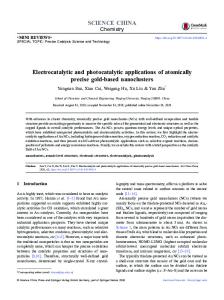Electrochemical and photocatalytic applications of Ce-MOF
- PDF / 1,708,363 Bytes
- 10 Pages / 595.276 x 790.866 pts Page_size
- 41 Downloads / 337 Views
Bull Mater Sci (2020) 43:269 https://doi.org/10.1007/s12034-020-02225-0
Sadhana(0123456789().,-volV)FT3](012345 6789().,-volV)
Electrochemical and photocatalytic applications of Ce-MOF S SANGEETHA and G KRISHNAMURTHY* Department of Chemistry, Jnanabharathi Campus, Bangalore University, Bangalore 560056, India *Author for correspondence ([email protected]) MS received 1 April 2020; accepted 6 June 2020 Abstract. We report on the applicability of an easy and general synthesis procedure for the formation of Ce(IV)-MOFs. Cerium-based metal–organic frame (Ce-MOF) was successfully synthesized by a simple, cost-effective and green route. Highly homogeneous topology, nano-sized crystals, stable oxidation states Ce(III) and Ce(IV) at room temperature, significant surface area and thermal stability up to 320°C are the notable properties achieved by Ce-MOF. Electron transferability of the cerium electrode was used for the detection of methylene blue (MB) analyte in acidic buffer solution. Also the effect of different pH buffer solutions on electrode response has been studied. Photocatalytic performance of nano-Ce-MOF was studied on the degradation of MB analyte under visible light. Keywords.
1.
Ce-MOF; surface area; thermal stability; electrochemical detection; photocatalytic activity.
Introduction
Metal–organic frameworks are solid materials, they differ from other materials by tunable pore sizes, large surface area, diverse chemical functionalities and stability, which make them suitable candidates for applications in vast fields, including separation, drug delivery, gas storage, sensor technology and catalysis [1–5]. Recently, ceriumbased MOFs received great interest and have been reported more in numbers due to their large surface area and superior catalytic property. Here we have reported, synthesis, characterization and applications of Ce-MOF. In comparison with the solvothermal and hydrothermal synthesis [6], the stirring route is low cost and environmentally friendly. Hence we successfully synthesized cerium benzene dicarboxylic acid (Ce-bdc) MOF by a simple, cost-effective method with green strategy. The crystalline nature of the product was studied by powder X-ray diffraction (PXRD) and other characteristics were studied by scanning electron microscopy (SEM), BET, thermo-gravimetric analysis (TGA), X-ray photoelectron spectroscopy (XPS) and photoluminescence (PL) analysis. The obtained product has shown good surface area, multiple oxidation states, high homogeneity, considerable stability and electron charge transfer behaviour. Hence, Ce-MOF has been tested for electrochemical sensor and photocatalytic applications. The redox behaviour of the Ce-MOF/cp electrode was studied by cyclic voltammetry. This electron transferability is utilized for the detection of hazardous, carcinogenic methylene blue dye (MB). In addition, the catalytic activity of Ce-MOF was studied by complete degradation
of MB dye under visible light and about 96% efficiency was shown by the Ce-MOF.
2. 2.1
Experimental Materials and me
Data Loading...











